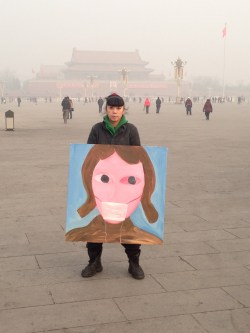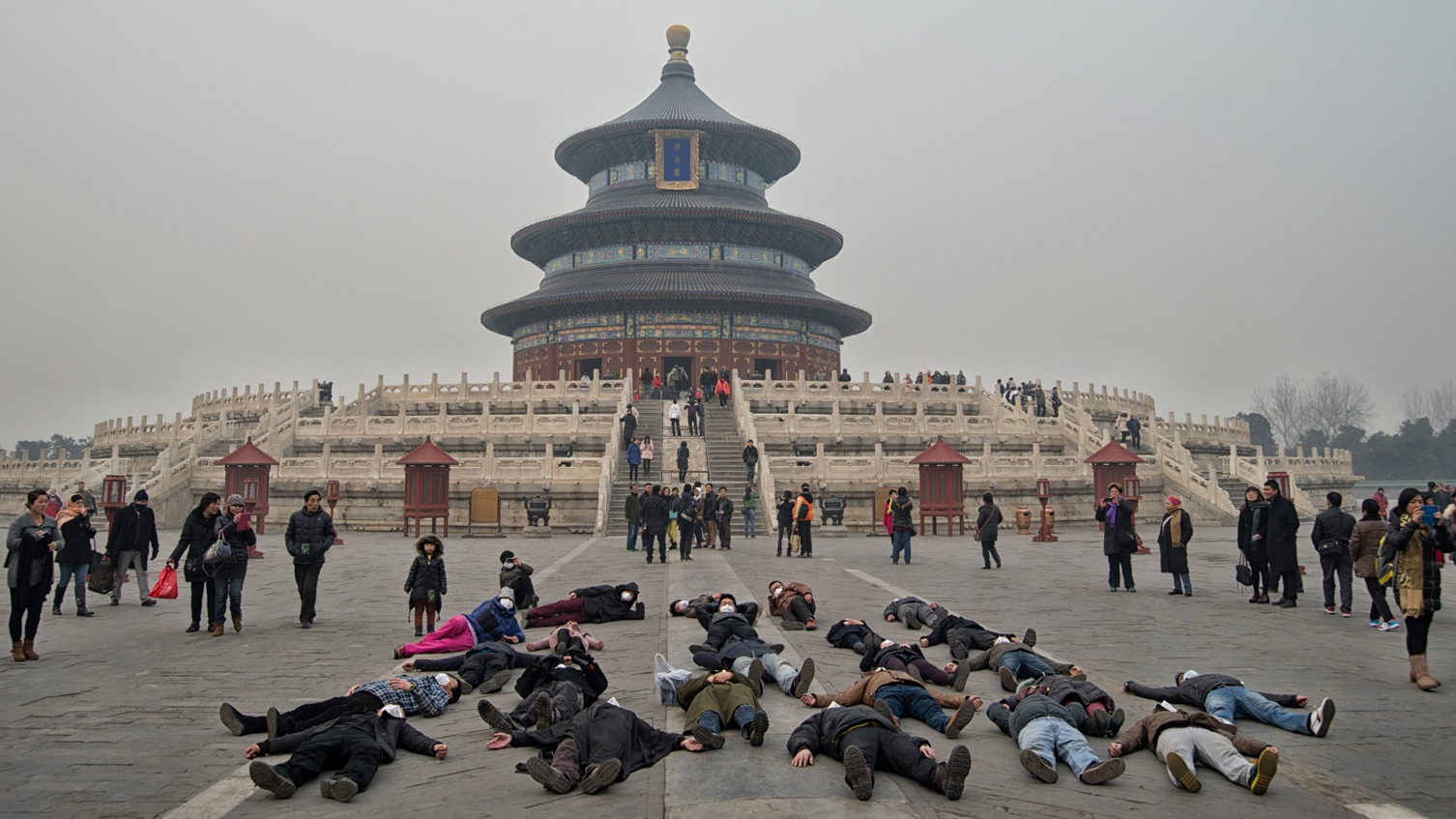When Kong Ning left her studio on Jan. 16, 2014, she was fed up. Pollution levels in Beijing had shot up to more than 18 times what the World Health Organization deems healthy. Outside, every other person wore a face mask to protect against the haze clinging to the city.
Before leaving, Kong Ning impulsively snatched one of her canvases and brought it with her. “The smog is really bad — I want people to see my painting,” she remembers thinking. The piece she’d grabbed, one of a series of 11 works in oil called “Smog Baby,” depicted a girl with different-colored eyes wearing a face mask.
In the nearly 14 years since she left her career as a lawyer, Kong Ning has devoted her life to creating art that expresses her feelings toward the environment she has watched deteriorate around her. That day, she wanted to make a statement.
“I thought that Tiananmen [Square] is the place all Chinese people feel the most strongly about [as a symbol],” she said of Beijing’s heavily policed central square, built by Chairman Mao Zedong in 1958 and known for the protests that took place there in June 1989. “The pollution was bad so I just went there to document it.”
With the help of a tourist she encountered when she arrived there, she managed to take several photos of herself holding the painting in front of the iconic Chairman Mao picture that hangs on the Forbidden City. Then she was kicked out by armed guards. She immediately posted her photos on WeChat, a popular Chinese social media site, where they spread quickly. They plainly hit a nerve among frustrated Chinese netizens.
 “For her carrying a canvas inside [Tiananmen Square], to do this kind of performance art, it’s really amazing and also brave,” said Catherine Cheng, Kong Ning’s friend and a prominent art curator who reposted the photo on her social media feed that day. Another person to pick up on the photo was a BBC journalist, who did a story about Kong Ning a couple of weeks later.
“For her carrying a canvas inside [Tiananmen Square], to do this kind of performance art, it’s really amazing and also brave,” said Catherine Cheng, Kong Ning’s friend and a prominent art curator who reposted the photo on her social media feed that day. Another person to pick up on the photo was a BBC journalist, who did a story about Kong Ning a couple of weeks later.
China’s chaotic economic development and the colossal energy needs of a population of 1.35 billion urbanizing citizens have left widespread land, water, and air pollution in their wake. A recent state study found that more than 19 percent of China’s farmland is polluted, and another study found that 60 percent of its groundwater is unhealthy.
Most recently, though, air pollution in China’s cities has caught the attention of global media. Over-reliance on coal-fired power plants, skyrocketing automobile emissions, and cold, dry winters have left northern cities like Beijing with smog and haze problems unimaginable in the Western world today.
Of course, the issue has its complexities: The development that’s causing the pollution has brought hundreds of millions out of poverty; China is traveling the same road blazed in previous centuries by industrializing powers in Europe and North America; besides, even if China is the world’s largest polluter, it is also investing the most in renewable energy and beginning to regulate its polluters.
However you view the causes and excuses, though, China’s air is in trouble. January 2013 saw China’s first “airpocalypse” — when air pollution in Beijing basically broke the metrics used to measure airborne particulate matter concentrations. The World Health Organization recommends that levels of PM2.5 (particles with a diameter of less than 2.5 micrometers, small enough to lodge in human lungs and bloodstreams) should stay below 25 micrograms per cubic meter; instead, days during that stretch far surpassed the 500 upper limit of the U.S. Air Quality Index (AQI). This past February saw extremely hazardous pollution levels again; AQI readings threatening to reach 500 persisted for more than a week.
While many Chinese people living in polluted cities have become increasingly frustrated, in a society that forbids public demonstration and political protest, most can do nothing more than complain to friends and family. Yet an increasing number of people are finding creative ways to both critique and document this era of air pollution, as well as to educate people how to protect themselves from it. They have resorted to performance art and public creative expression in the place of marching or soapboxing.
This past December, for example, several college students in the central city of Xi’an covered themselves in plastic, representing smog, and pretended to choke on it in a public square. Later in February, when pollution levels became dangerous for several days on end in Chongqing (further west in China), residents took to the streets on bikes wearing face masks with “CO2” drawn on them behind a red, circular “prohibited” sign.
The same week that Kong Ning went to Tiananmen Square with her painting, students at Peking University crept around campus putting face masks on statues of historic scholars, like Communist Party co-founder Li Dazhao. The next day, 20 performers, also in face masks, gathered in front of the Temple of Heaven, the landmark in Beijing where the emperor used to pray for a good harvest, and laid themselves down in a symbolic prayer for clean air. In March, a group in the city of Changsha gathered for a symbolic funeral for China — which was dying, they implied, from air pollution.
Still others have used the internet to spread photos of these performances, as well as satirical songs and comics, on WeChat and Weibo, China’s most popular social media websites. In April, one Chinese artist made a splash during a trip to the south of France: According to the AP, he captured some Provencal countryside air in a glass jar and then put it up for bid at an auction attended by prominent Chinese art collectors. The jar fetched over $800.
Li Tianyuan, a prominent painter and art professor at Tsinghua University in Beijing, blew up microscopic images of the pollution particles being inhaled by people living in polluted cities and has been showing them in prominent Beijing art galleries. “There are two goals,” he said. “The first is to make clear what this smog is. The second reason is to help everyone in society to protect themselves individually, to give them that awareness.”
In fact, it was only recently that the vast majority of Chinese people became aware of the hazards of smog — long after food contamination and water pollution had become hot-button issues.
Wu Di, who photographed the group prayer at the Temple of Heaven, remembers that the 2008 Summer Olympic Games in Beijing gave pause to many Chinese people, including himself.
“During the Olympics, I saw the American athletes wore face masks when they came to China,” he told me in his airy studio. (As with all the interviews in this story, I have translated his quotes.) “A lot of people thought that was very hard to understand. ‘Why are they wearing face masks?’ They felt these athletes were humiliating our country. But actually, from that time I already had started to think about how they weren’t wearing those face masks for no reason.”
At this point, Wu Di was still working 9 to 5 at a security surveillance firm, but he started to do some research in his spare time. He learned about PM2.5 particles and the health risks they pose. The United States Embassy in Beijing began publicizing the readings of PM2.5 levels in the city after the Olympics in 2008, and the American consulates in Guangzhou and Shanghai started sharing that data in following years. But the Chinese government did not follow suit, and pressured foreign governments to stop as well.
That changed with an extreme air pollution episode in October, 2011; by the next January, the Chinese government finally began publicizing its pollution readings. Since then, many more in China have realized the hazards of long-term exposure to particulates and have begun to take measures to protect themselves, like wearing face masks and buying air filters for their homes.
Wu Di quit his job not long after the Olympics to devote himself to photography highlighting the dangers of climate change and pollution. One image used on Greenpeace East Asia’s website shows a little girl holding two heart-shaped balloons. An air tube, the kind someone with emphysema would use, leads from her nostrils to the balloons. The hazy background features the iconic, hollow square building that serves as headquarters for China Central Television.
Another shows the same girl in front of the Temple of Heaven wearing 445 facemasks, the number Wu Di calculated she would need to wear by 2030 if pollution levels stayed the same.
“The goal [of my work] on the one hand is to create art, but on the other hand it is to hopefully help the public understand even better the environmental problems and how to protect themselves,” he said. “At the same time, it also tries to be a piece of criticism.”
The prayer performance at the Temple of Heaven, for example, was a biting message of how bad things had become, and Wu Di’s photo of it spread quickly through social media and on news sites.
Another goal of artists like Wu Di is to record the pollution for posterity. He has spent the past half-year taking pictures and video of the coal-fueled power plants in the provinces surrounding Beijing, which are responsible for most of the air pollution in northern Chinese cities. He finds the project important because many people don’t know where air pollution comes from. “A lot of people think it’s from automobiles or cooking,” he said.
He continued, “In the future, I want these works to accurately record a history of what’s going on in this era just like the 19th century in England or the industrial revolution in America.”
Li Tianyuan, the Tsinghua University art professor whose blown-up photographs of pollution particulates currently hang in the 3 Shadows Gallery in Beijing’s Caochangdi art district, wants to document the pollution, too, but on a smaller — actually, microscopic — scale.
“A lot of people don’t know what PM2.5 is,” he said. “They are all talking about it but don’t know what it is exactly. I want to establish what all of the particles in the air look like so people can see them very clearly, and understand … where they come from.”
Kong Ning too hopes to “leave her art for later generations” while also warning people today of the dangers of neglecting their environment. “My main goal is to express … a desire to protect the environment and nature and life … because that is essentially all we have, right?”
Despite these efforts, waking up morning after morning to oppressive, deadening smog can become disheartening. But these artists maintain hope and a commitment to doing something, however small, about it.
“I still have hope. If there was no hope, I would not go out and do these things,” Wu Di said.



